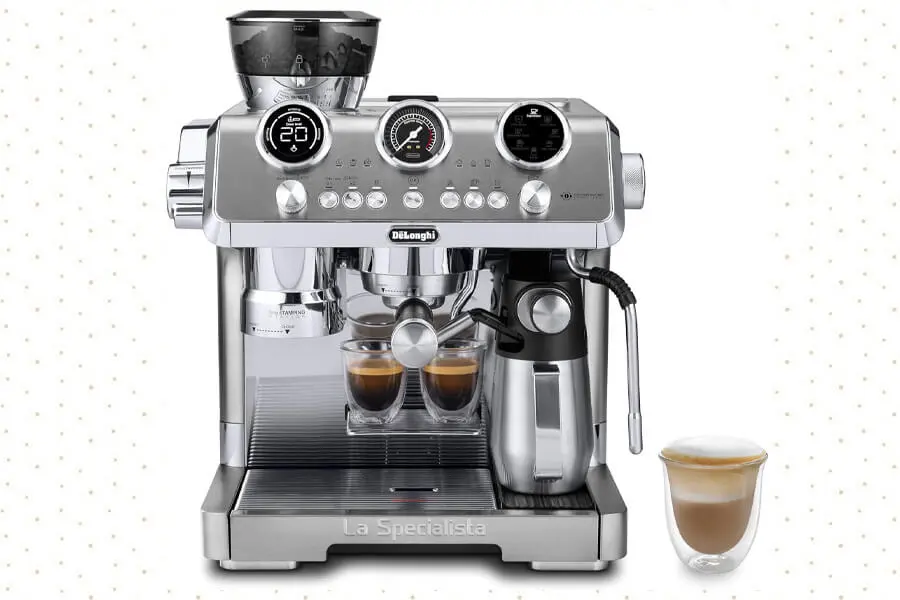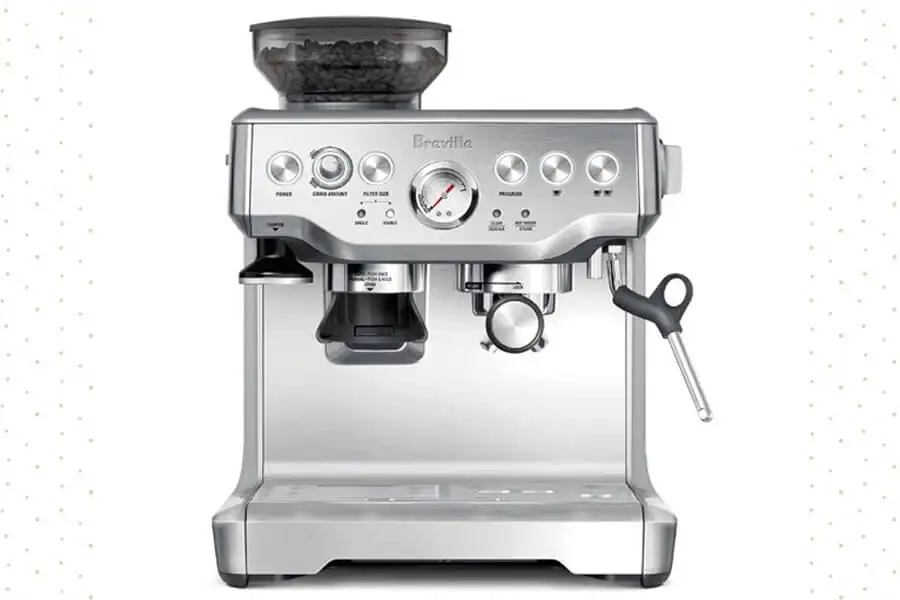If you’ve landed here, chances are you’re on the hunt for the perfect espresso coffee machines but feel overwhelmed by the options. With so many features, prices, and styles, it’s hard to know which one truly delivers. Let’s break it down to help you choose the best espresso machine for your home.
The Winners
- Breville Barista Pro – For the coffee lover who values both performance and convenience, the Breville Barista Pro combines advanced features with user-friendly design.
- De’Longhi La Specialista Maestro – This machine’s semi-automatic functionality and added control over extraction give you an excellent balance between convenience and customizability.
These two are ideal for those wanting a quick pick based on quality and reliability. Click through for the latest deals!
How We Chose the Best Espresso Coffee Machines
In selecting the best espresso machines, we evaluated dozens of models for key factors such as brewing performance, durability, ease of use, and overall value. Our choices reflect both user feedback and our own rigorous testing, focusing on machines that consistently produce high-quality espresso.
#1 Breville Barista Pro
The Breville Barista Pro excels with its intuitive interface, powerful steam wand, and integrated conical burr grinder, which allows for precise grind control. Its ThermoJet heating system reaches the optimal temperature in just three seconds, making it a time-saver in busy mornings.
With options to adjust grind size, temperature, and extraction time, it’s the ideal pick for enthusiasts wanting a semi-automatic experience with a professional touch.
Advantages
- Quick heat-up time
- Built-in grinder with grind size control
- Durable stainless steel build
- High-quality steam wand
- User-friendly interface
Disadvantages
- Higher price point
- Can be bulky for small kitchens
- A high-quality semi-automatic machine known for its precision and speed. It includes an integrated grinder with 30 settings and a fast heat-up time. The Barista Pro delivers café-quality espresso and excellent milk frothing capabilities, making it ideal for home baristas.
- Best for: Intermediate to advanced users.

Breville Barista Pro
- Quick Heat-Up Time
- Integrated Grinder & Dose Control
- User-Friendly Interface
- Powerful Steam Wand
- Durable Build
#2 – De’Longhi La Specialista Maestro
The La Specialista Maestro is a dream for anyone seeking both ease of use and control over their espresso. It has a sensor grinder to ensure precise dosing and features an advanced LatteArt steam wand for enhanced milk frothing.
This machine stands out for its dual heating system, allowing you to brew and steam without delays, making it perfect for those who love making multiple drinks in a row.
Advantages
- Dual heating system
- Precise sensor grinder
- LatteArt steam wand for frothing
- Easy pre-set recipes
- Stylish and sleek design
Disadvantages
- Requires regular cleaning
- Learning curve for beginners
- This luxury machine is highly automated, with features like auto-tamping, grinding, and pre-infusion, making it easy to use while delivering high-end espresso. It’s perfect for those who want a versatile machine that even supports cold brew.
- Best for: Those looking for luxury and automation.

De’Longhi La Specialista Maestro
- Sensor Grinding Technology
- Dual Heating System
- Advanced Latte Art Steam Wand
- Smart Tamping Station
- Six Specialty Drink Presets
- Active Temperature Control
- Premium Build and Design
#3 De’Longhi Dedica Style EC685
Compact and sleek, the De’Longhi Dedica Style EC685 is ideal for small spaces but doesn’t skimp on quality. It offers adjustable settings for both shot length and steam levels, making it a great entry-level machine for beginners.
Despite its smaller size, this machine offers powerful performance, making it easy to create a range of espresso drinks with a consistent quality that’s impressive at this price point.
Advantages
- Compact and space-saving design
- Adjustable shot length
- Consistent quality for price
- Fast heat-up time
- User-friendly operation
Disadvantages
- Limited water reservoir capacity
- Less durable than higher-end models
- A compact and budget-friendly option that takes both ESE pods and ground coffee. Despite its size, it delivers strong espresso with a decent crema and includes a manual milk frother. It’s simple and ideal for beginners or those with limited space.
- Best for: Budget-conscious espresso lovers.

De’Longhi Dedica Style EC685
- Compact Design
- Thermoblock Heating System
- Adjustable Settings
- Manual Milk Frother
- 15-Bar Pump Pressure
- Easy to Use
- Dual Compatibility
#4 Breville Barista Express
A favorite among home baristas, the Breville Barista Express offers great control with its integrated grinder, adjustable grind size, and dose control. This model gives you everything needed for a professional espresso experience at home.
For anyone looking for a bit more manual control but still wants an all-in-one machine, the Barista Express is a reliable choice.
Advantages
- High-quality built-in grinder
- Adjustable grind size
- Dose control for consistent shots
- Includes frother for milk drinks
- Durable stainless steel construction
Disadvantages
- Limited water reservoir capacity
- Less durable than higher-end models
- A widely popular model, it combines an integrated grinder and semi-automatic functionality. With its user-friendly design, it allows you to dial in settings for espresso shots, making it a go-to for beginners and advanced users alike.
- Best for: Beginners seeking to learn barista skills.

Breville Barista Express
- Integrated Conical Burr Grinder
- Dose Control
- PID Temperature Control
- Manual and Automatic Options
- Powerful Steam Wand
- Easy-to-Use Interface
- Durable, Stylish Design
#5 – Smeg BCC13
The Smeg BCC13 is a stylish choice with its retro aesthetic and user-friendly features. It has a one-touch control panel and a built-in grinder, making it a convenient option for coffee enthusiasts who prioritize simplicity without sacrificing quality.
This machine is perfect for those who want easy, quick access to a morning espresso without the need for complex settings.
Advantages
- Sleek retro design
- One-touch control panel
- Built-in grinder
- Compact size
- Easy to clean
Disadvantages
- Limited control over brewing parameters
- Higher cost for aesthetic appeal
- This fully automatic machine handles the entire process from grinding to frothing, producing consistent, well-extracted espresso. Its compact design is great for smaller spaces, and the automatic frother makes it easy to create creamy milk-based drinks.
- Best for: Those who want an automatic, hands-off experience.
These machines vary in price and features, from high-end luxury options to more budget-friendly, compact models, ensuring there’s something for everyone.

Smeg BCC13
- Compact, Stylish Design
- One-Touch Operation
- Integrated Burr Grinder
- Thermoblock Heating System
- Adjustable Milk Frother
- Customizable Settings
- Easy Cleaning and Maintenance
What to Look for in an Espresso Machine
When choosing an espresso machine, consider factors such as:
- Machine Type: Semi-automatic, automatic, or super-automatic options vary in the level of control.
- Size and Design: Ensure the machine fits your kitchen space and matches your aesthetic preference.
- Grinder: A built-in grinder is a big plus, as fresh grinding is essential for flavor.
- Steam Wand Quality: If you enjoy milk-based drinks, a quality steam wand will make a difference.
- Ease of Use and Maintenance: Some machines are more beginner-friendly, while others require more experience.
Consider your budget
When choosing an espresso machine, it’s important to think about your budget. High-quality machines can be expensive, but there are also affordable options available that offer great features.
For example, a beginner may want to consider the DeLonghi ECP 3420 – an entry-level pump driven espresso and cappuccino maker which is under $100 yet capable of producing barista quality drinks at home.
Those looking for something with more advanced features may need to sacrifice some price range – like getting a super automatic or semi-automatic machine in the $300-$1,000 range—or look into commercial grade espresso machines if they have a larger budget.
Determine your preferred brewing method
It’s important to consider your preferred brewing method when choosing the best espresso machine. Your coffee preferences will dictate which machine will be most suitable for you and your needs.
Different machines employ different brewing methods to create a variety of drinks such as lattes, cappuccinos, macchiatos, Americanos and even simple espresso shots.
The type of coffee drinks you prefer is an important factor in selecting an espresso maker that can accommodate them. Understanding the various brewing techniques allows us to determine our preference of drink taste, consistency, and quality all based on the capabilities truthfully provided by a certain model or brand.
Check for additional features
When shopping for an espresso machine, it is important to check for additional features that can make the coffee-making process a lot easier. An ideal espresso machine should have programmable settings in order to brew shots and other types of beverages at just the right temperature with minimal fuss.
Moreover, modern machines are equipped with features like cup warmers, milk frothers, portafilters and grinders which not only maximise convenience but also enhance the taste profiles of your drinks.
Many premium models also feature LCD screens or touchscreens that provide precise control over pressure levels and customisation options so you get consistent results every single time.
This makes them perfect for experienced baristas who demand professional quality coffee from their machines as well as for novice users looking to learn more about home brewing without having to invest too much time learning new techniques.

Read customer reviews
Reading customer reviews is a crucial part of the decision-making process when buying an espresso machine. On popular sites such as Amazon, Target and Best Buy, customers can easily access customer feedback on the different models available in order to learn more about performance and overall satisfaction with each model.
Knowing what others experienced in terms of reliability, durability over time and ease of use provides additional information that can’t be found in product descriptions or advertisements.
Insights from people who have already used an espresso machine are especially valuable because they provide firsthand knowledge on the quality of the product being purchased. Compare individual comments against each other so you get a better picture on whether this particular model would suit your needs.
How Do You Maintain an Espresso Machine?
Regular cleaning and maintenance is essential for the proper functioning of an espresso machine. To ensure that your coffee maker continues to serve deliciously brewed beverages, it’s best practice to clean it on a regular basis with the right tools and techniques.
It is recommended to clean the group with a brush and perform a full detergent backflush every six months. Cleaning the grinder and steam wand should also be done at least once every six months or when there are signs of buildup on them.
Additionally, descaling an automatic espresso make can help keep its functions consistent while extending its life span so this should be done regularly as well. Coffee equipment must have daily and weekly upkeep performed by qualified personnel while undergoing tune-ups around every six months or whenever required.
Wrapping Up
After reviewing these top options, it’s clear that each espresso machine serves a specific need. The Breville Barista Pro is ideal for those seeking a balance of control and convenience, while the De’Longhi Dedica Style EC685 is perfect for beginners with limited space. For a stylish addition to your kitchen, the Smeg BCC13 offers easy operation with a touch of retro design. No matter your choice, each of these machines brings quality espresso to your home.




